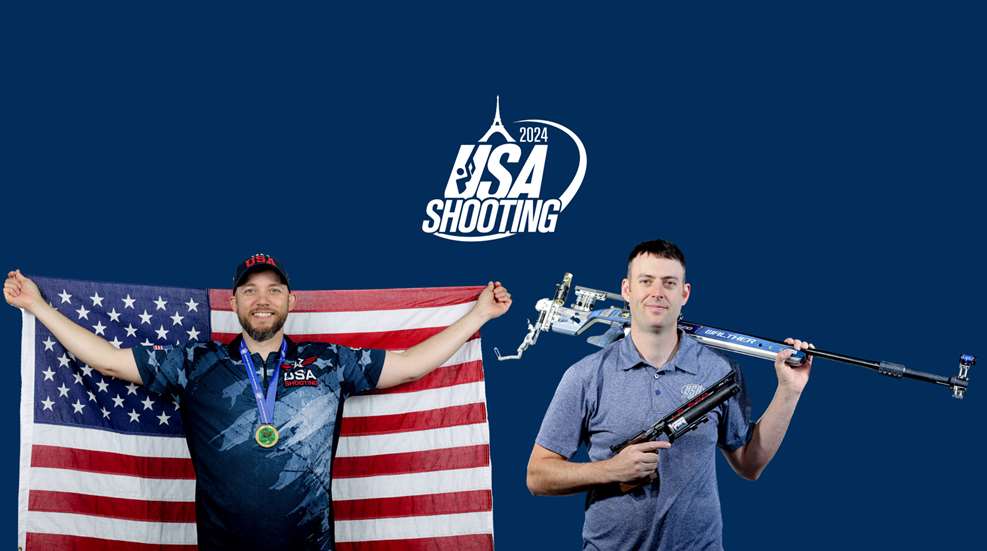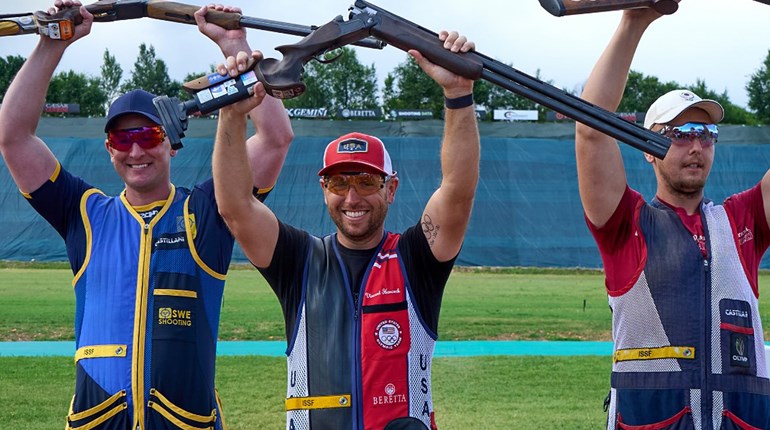
Most athletes with Olympic dreams are specialists. It takes a tremendous amount of time, effort and focus to become internationally elite at anything. In shooting, most settle on one of the disciplines early on—either rifle, pistol or shotgun. But a few of USA Shooting’s National Team members have successfully broken the mold. Nick Mowrer and James Hall are two examples, both Olympic hopefuls on the Path to Paris.
In 2021 at the Tokyo Games, Mowrer became the first American to compete in more than one discipline at an Olympics when he competed in both Men’s 10m Air Pistol and 50m Smallbore Rifle. He had already competed in Men’s Free Pistol at the 2012 London Games. He has won World Cup medals in both rifle and pistol, was the four-time aggregate Collegiate Pistol Champion in 2008, 2010, 2011 and 2012, and was the NRA National Rifle Junior Champion in 2008.
Hall competed alongside Mowrer at the Olympics in the Men’s 10m Air Pistol event in Tokyo. He had initially been a rifle shooter, only starting pistol competition when he was almost 30. He was an NRA Rifle All-American for four years at Jacksonville State University, where he led the team to an NCAA Smallbore National Championship in 2005. He was named the Conference Smallbore and Air Rifle Most Valuable Player in 2005 and 2006.
How is it that these two athletes have managed to find success in both rifle and pistol when the conventional path is long-term specialization? Their versatility likely stems from the fact that both Mowrer and Hall are avid all-around shooters.
“If it’s got a trigger, I want to pull it.” Hall said. “I’ve competed in CMP high power, USPSA, 3-gun, steel challenge, long range air rifle, bullseye pistol and prone matches. In 2022, I participated in the television show “American Airgunner” and got the opportunity to do lots of crazy trick shots. I love all shooting sports … I’ve often joked with Nick that if competitive slingshot was a thing, we would do that too.”
Hall’s interest began when he was young. He and his three younger brothers wanted to try shooting, but they faced some resistance. “My mom wasn’t thrilled about the idea,” he said. “She signed us up for a Hunter Ed class thinking she could bore us out of the idea with classroom training.” Instead, it had the opposite effect. All four boys found a love of shooting and their mother became their club’s coach for several years, as well as a beloved volunteer at USA Shooting competitions.
Mowrer echoes Hall’s sentiment: “Anything that has a projectile that leaves from it I am familiar with, to include your traditional slingshot. I love hunting and providing for the family in that regard has been rewarding also.”
He began with high-power rifle in 2002 accompanied by indoor bullseye pistol in the winter. Smallbore rifle came later, and his interest grew from there. “I was going to any match I could among those sports anywhere I could,” Mowrer said.
Both athletes love the shooting sports and the people. “My favorite part of shooting sports has been the relationships I’ve built in the community, and I think that transcends to each discipline,” Hall said.
Mowrer added, “I always liked hanging out talking about the [shooting] sports … and showing up on the weekend and hanging out for some friendly competition.”
Rifle and pistol disciplines might look quite different at first glance. Rifle shooters use bone support to hold their positions and wear heavy specialized clothing to provide support, reduce motion and prevent stress injury. In contrast, pistol shooters cannot use any bone support and wear normal street clothing. But at the core, the two disciplines have enough overlap that shooting both well isn’t a stretch.
“The fundamentals are exactly the same between the two,” Mowrer explained. “If you can do one, you can do the other … They align well together, and one will teach you things you need for the other.”
Hall provided an example, “You really understand what trigger control is by shooting pistol.”
There are differences, however. Mowrer said, “[With rifle], there are more equipment challenges to overcome and [with] pistol there are more physical challenges to overcome.” It’s easy to see why—rifle shooters lug large suitcases full of gear to the firing line and their rifles have a myriad of adjustments to tweak, while pistol shooters have only a small box for their relatively simple pistol and a few other items.
Take wind conditions during outdoor competition as another difference between the two. “If the wind is blowing in pistol hard enough to matter, then it’s blowing you hard enough [that you] have something much bigger to worry about,” Mowrer said. Wind can easily push around an unsupported arm and hand and cause the body to sway, making the hold area much larger, and shooting a ten more difficult.
However, wind reading is a crucial technical skill in outdoor rifle shooting. The rifle is more supported, two of the three positions are low to the ground (prone and kneeling), and the target is smaller. This means that the wind’s effect on the bullet itself—rather than the body—becomes a vital consideration. Reading wind flags, mirage and even the motion of the trees or plants downrange and adjusting sights or strategy accordingly must be part of an elite rifle shooter’s skill set.
Hall and Mowrer have more in common—they are both working fathers, balancing family life and jobs with their training. To make this lifestyle work, support and flexibility from family is imperative and something both are grateful for.
A member of the Army World Class Athlete Program (WCAP), Mowrer said, “My wife is my biggest supporter, but on days where it’s on me to train and be Dad, my daughter has no issue hanging out at the range with me. She spends her time playing with her toys, reading, doing her homework, making friends with the other shooters and office staff, and even gets a little shooting in herself. She is six years old.”
Hall is employed in the civilian world. “I work full time for the Scholastic Shooting Sports Foundation, have two young kids at home, love getting into car projects, and have a long honey-do house list from my wife,” he said. “My family and I set goals together and prioritize our time to achieve those goals. Having my family support my Olympic dreams helps keep me focused when it’s easy to get overwhelmed with a busy schedule.”
It’s the Olympic dream that keeps them both motivated with so much to balance. For Mowrer, it began when he learned shooting was an Olympic sport. “It was probably when I watched Matt Emmons on TV during the 2004 Games,” he said. Emmons won gold in 50m Prone Rifle for the United States that year and was on track to win another gold in 50m 3-Position Rifle until the last shot of the final.
Hall’s Olympic goals began while he was shooting rifle at Jacksonville State University and competed in his first Olympic trials. “After college I began working full time and quit international rifle competitions; however, I still had the desire to keep competing, so I started playing around with an air pistol for fun,” he said. “The 2012 Olympic trials were coming up and I figured I’d sign up since they were local. That year, with relatively little practice, I made the finals and realized I should give this a real run for the next quad.”
With successful showings at the first part of Olympic trials for Paris 2024 under their belts, these dedicated shooters are in the hunt. Hall is currently in second place in Men’s 10m Air Pistol. Mowrer is third for Men’s 10m Air Pistol and is tied for fifth in Men’s 50m Smallbore Rifle. They have two more trials competitions to face on their Path to Paris before our 2024 Olympic Shooting Team is named. For each of them, earning a spot on the team would be an accomplishment and an honor.
“I appreciate the opportunity to participate in each [international competition] and am always honored to represent Team USA,” Hall said. “Making the Paris 2024 Olympic team shows the world what I’ve been doing for the last three years since Tokyo.”
“I love the opportunities I have had to represent my country in international competitions, and I hope to represent again,” Mowrer said. “Nothing [is] more rewarding than working hard for a big personal goal and then feeling the support of a nation pushing towards that goal. It’s a huge honor and one I do not take lightly. Let’s go 2024.”
Learn more about USA Shooting at usashooting.org.


































